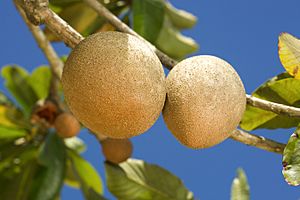Mamey sapote facts for kids
Quick facts for kids Mamey sapote |
|
|---|---|
 |
|
| Scientific classification | |
| Genus: |
Pouteria
|
| Species: |
sapota
|
| Synonyms | |
The mamey sapote (its scientific name is Pouteria sapota) is a type of tree that grows naturally in places like Cuba, Mexico, and Central America. You can find it from southern Cuba all the way to southern Costa Rica.
Today, people grow mamey sapote trees in many areas. This includes Central America, the Caribbean, and even South Florida. Its fruit is very popular in many Latin American countries. In the USA, you might find mamey used in yummy milkshakes and ice cream!
In some Latin American countries, it has names like mamey colorado (Cuba) or zapote rojo (South America). These names mean "red mamey" or "red sapote." They help tell it apart from a different fruit called "yellow mamey" (Mammea americana), which looks similar but is not related.
Scientists in Australia have also started growing mamey sapote as part of their research.
Contents
What is Mamey Sapote?
The mamey sapote is a large, beautiful evergreen tree. This means it stays green all year round. It can grow very tall, sometimes reaching up to 45 meters (148 ft), which is like a 15-story building!
Most mamey sapote trees are grown by a method called grafting. This is like taking a branch from one tree and attaching it to another. Grafting helps make sure the new tree will have the same great fruit as the parent tree. It also makes the tree grow fruit much faster. Grafted trees can produce fruit in just three to five years. Trees grown from seeds take longer, about seven years. In Florida, the fruit is usually ready to pick from May to July. Some types of mamey sapote are available all year.
The Fruit and Leaves
The mamey sapote fruit is actually a type of berry. It is usually about 10 to 25 cm (4 to 10 in) long and 8 to 12 cm (3 to 4.5 in) wide. The inside of the fruit can be pink, orange, or red. Its brown skin feels a bit rough, like sandpaper, or sometimes fuzzy like a peach.
When you eat it, the fruit is creamy and soft. People describe its taste as a mix of sweet potato, pumpkin, honey, and other fruits like peach or apricot. You know a mamey sapote is ripe when its skin peels off easily. The inside should be a bright salmon color. Also, the flesh should feel a little soft, like a ripe avocado.
The leaves of the mamey sapote tree are long, about 4 to 12 inches. They are pointed at both ends and grow in groups at the ends of the branches.
Mamey Sapote's Relatives
The mamey sapote is related to other "sapote" fruits. These include the sapodilla (Manilkara zapota), abiu (P. caimito), and canistel (P. campechiana). However, it is not related to the black sapote (Diospyros nigra) or the white sapote (Casimiroa edulis).
How People Use Mamey Sapote
People enjoy eating the mamey sapote fruit raw. It is also very popular in milkshakes, smoothies, and ice cream. You can even find it made into fruit bars. Some people use mamey sapote to make marmalade and jelly.
Did you know that oil pressed from the mamey sapote seed is used in some beauty products? This oil is also known as sapayul oil.
Mamey Sapote Nutrition
Mamey sapote fruit is very good for you! It is an excellent source of vitamin B6 and vitamin C. It also provides a good amount of riboflavin, niacin, vitamin E, manganese, potassium, and dietary fiber. Scientists have even found new types of carotenoids (which are good for your health) in the ripe fruit.
Images for kids
See also
 In Spanish: Zapote para niños
In Spanish: Zapote para niños







